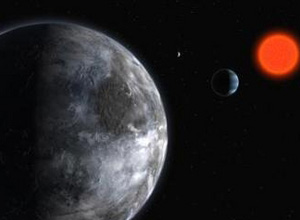 |
 |
 |
 Editorials | Environmental | April 2007 Editorials | Environmental | April 2007  
Scientists Find Most Earth-Like Planet Yet
 Maggie Fox - Reuters Maggie Fox - Reuters


| | An artistic illustration released by the European Southern Observatory shows the new planet known as Gliese 581 c (L) orbiting a red dwarf star, April 25, 2007. (European Southern Observatory) |
European astronomers have spotted what they say is the most Earth-like planet yet outside our solar system, with balmy temperatures that could support water and, potentially, life.

They have not directly seen the planet, orbiting a red dwarf star called Gliese 581. But measurements of the star suggest that a planet not much larger than the Earth is pulling on it, the researchers say in a letter to the editor of the journal Astronomy and Astrophysics.

"This one is the first one that is at the same time probably rocky, with water, and in a zone close to the star where the water could exist in liquid form," said Stephane Udry of the Geneva Observatory in Switzerland, who led the study.

"We have estimated that the mean temperature of this super-Earth lies between 0 and 40 degrees Celsius (32 to 104 degrees F), and water would thus be liquid."

Most of the 200 or so planets that have been spotted outside this solar system have been gas giants like Jupiter. But this one is small.

"Its radius should be only 1.5 times the Earth's radius, and models predict that the planet should be either rocky, like our Earth, or covered with oceans," Udry said in a telephone interview.

It appears to have a mass five times that of Earth's.

The research team includes scientists credited with the first widely accepted discovery of a planet outside our solar system, in 1995.

Many teams are looking for planets circling other stars. They are especially looking for those similar to our own, planets that could support life.

That means finding water.

X MARKS THE SPOT

"Because of its temperature and relative proximity, this planet will most probably be a very important target of the future space missions dedicated to the search for extra-terrestrial life," Xavier Delfosse, a member of the team from Grenoble University in France, said in a statement.

"On the treasure map of the universe, one would be tempted to mark this planet with an X."

Gliese 581 is among the 100 closest stars to Earth, just 20.5 light-years away in the constellation Libra.

A light-year is the distance light travels in a year, about 6 trillion miles.

It is smaller and dimmer than the sun, so the planet can be close to it and yet not be overheated.

"These low-mass stars are the ones where we are going to be able to discover planets in the habitable zone first," said planet-hunter David Bennett of the University of Notre Dame in Indiana, who was not involved in the research.

Bennett cautioned that current temperature alone does not mean water still exists on the planet. It could have burned off ages ago, when the star was hotter than it is now.

Udry's team uses a method known as radial velocity, using the European Southern Observatory telescope at La Silla, Chile.

The same team has identified one larger planet orbiting Gliese 581 already and say they have strong evidence of a third planet with a mass about eight times that of the Earth.

Future missions, perhaps in 20 to 30 years, may be able to block the light from the star and take a spectrographic image of the planets. The color of the light coming from the planet can give hints of whether water, or perhaps large amounts of plant life, exist there. | 
 | |
 |



